Nestled on the east shore of Saginaw Bay just north of Sebewaing, Rose Island was long promoted as a picturesque getaway in Michigan’s “Thumb.” A 1910s map advertisement even dubbed it “The Resorters’ Mecca,” highlighting its proximity to Bay City, Saginaw and Detroit. (Sebewaing itself was known for its marina, campgrounds and quaint downtown.)
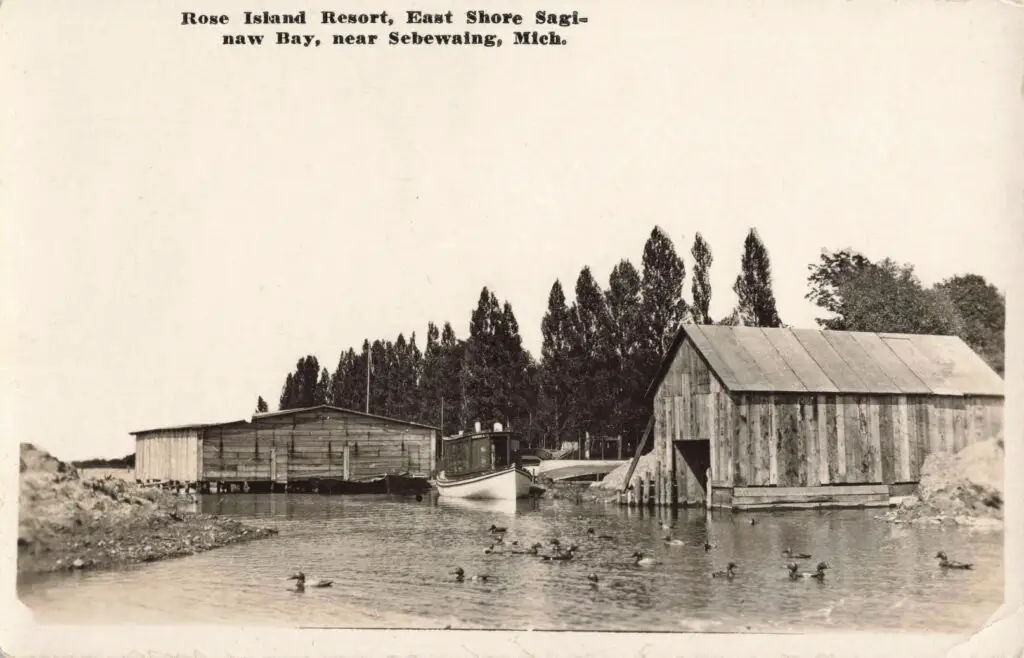
In summer months the warm, shallow waters of Saginaw Bay attracted vacationers from across the region, and by the 1910s small resorts and parks dotted the shoreline. Rose Island quickly became one of the most popular local retreats, offering bayfront scenery and a taste of “lake shore” living to early 20th-century Michiganders.
Beginnings: New Owners and Improvements (1916)
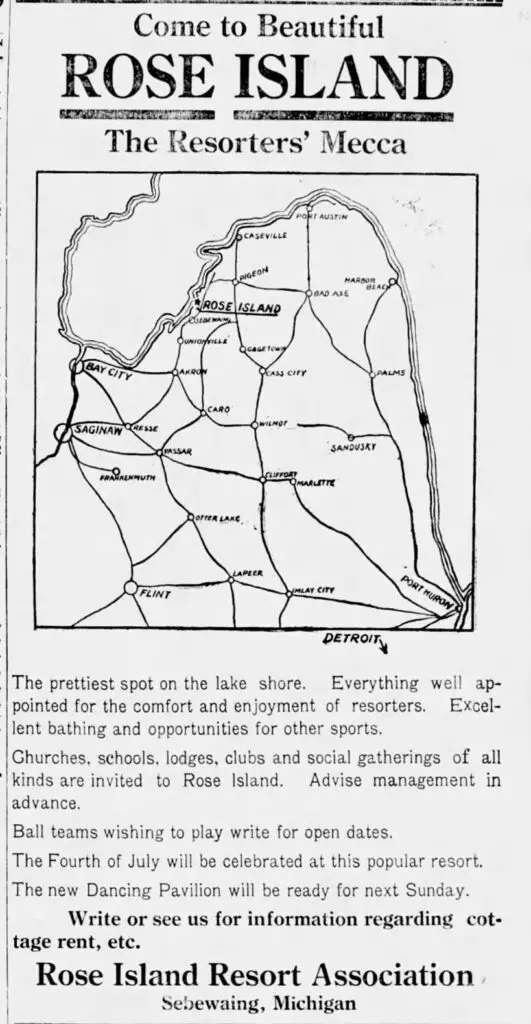
In spring 1916, a new chapter began for Rose Island. Newspaper reports announced that Fred G. Durkee and G. R. Durkee of Saginaw had purchased the Rose Island Resort from P. W. Selee. The Durkees were energetic investors: the local press noted they “will make considerable improvements on the place,” and believed it could become “more of a Mecca to resorters than ever”. Under their direction, crews began building up the facilities – plans included new lodging, shops and cottage lots to serve guests. By June 1916 the Rose Island Resort Association was ready for a grand opening: one newspaper announcement exclaimed that the new hotel was completed and ready to take care of all demands, and invited visitors to “spend the day here” enjoying the fine grounds (with the Sebewaing band playing on opening day).
(The Durkees had even planned a larger “big hotel,” but had put that particular project on hold for the time being. Instead they focused on a more modest hotel building and other amenities. The emphasis in 1916 was on making the Rose Island Resort attractive and affordable – the owners promised affordable meals, sporting events like baseball games, and “numerous amusements for the patrons of the resort.” Locals were told the resort boasted “a fine baseball park” and that many games would be played there during the summer.)
Around the same time, region-wide infrastructure improvements were underway. In May 1916 leaders in nearby Harbor Beach announced plans for a Huron Shore Pike – a scenic highway along the bay from Port Huron to Bay City. As a newspaper blurb put it, the Huron Shore Pike was “to be a road along the shores of Port Huron and Saginaw Bay… something that will be of inestimable value when completed”. (Decades later this would roughly become today’s M-25/M-29 route.) The promise of a better road encouraged more traffic to the Thumb’s bayfront resorts, including Rose Island. With growing accessibility, the Durkees’ timing seemed right: improved roads and publicity would help bring summer crowds to the newly revamped resort.
Summer Fun: Boating, Dancing and Picnics
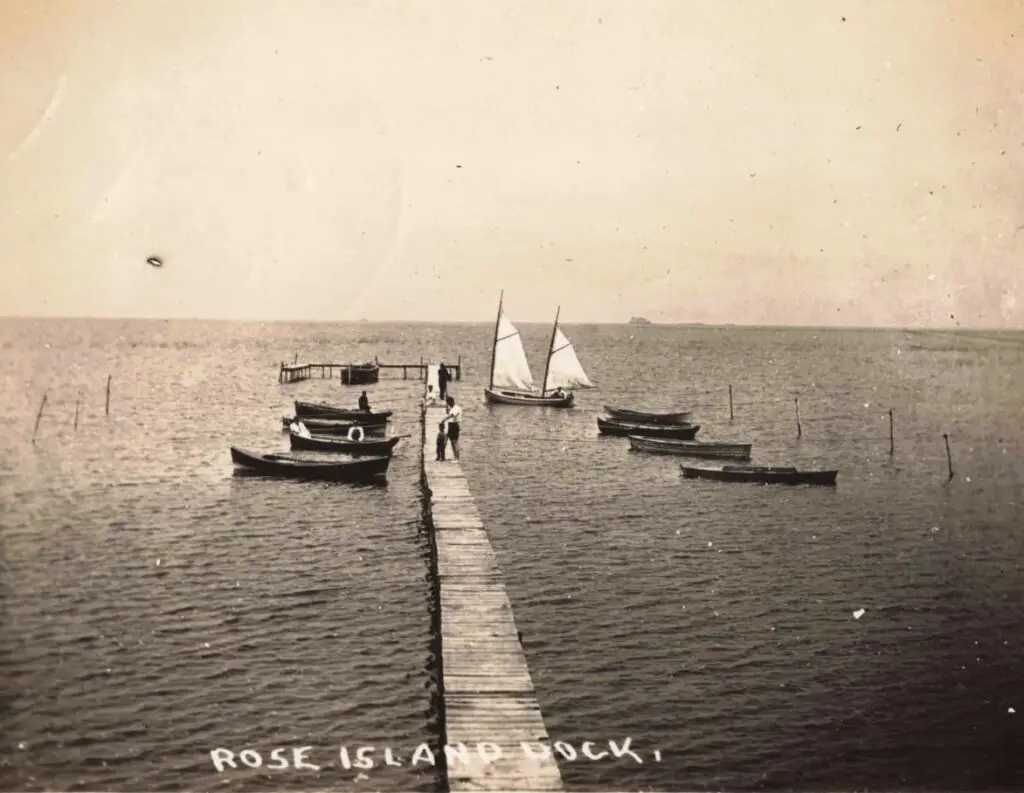
The early Rose Island Resort offered a variety of lakeside pleasures. Visitors could swim and wade in the bay, rent rowboats or motorboats from the resort’s bathhouse, and fish in Saginaw Bay’s shallow waters. The shores and groves of the island were laid out with picnic areas and open lawns; families were encouraged to “bring your lunch baskets and enjoy a day’s outing” on the grounds. A large dance pavilion became one of the resort’s signature features. (News stories of the time simply refer to “the dancing pavilion at Rose Island,” a covered hall built out over the water.) In the afternoons and evenings visitors could gather on the wooden floor for live music and dances.
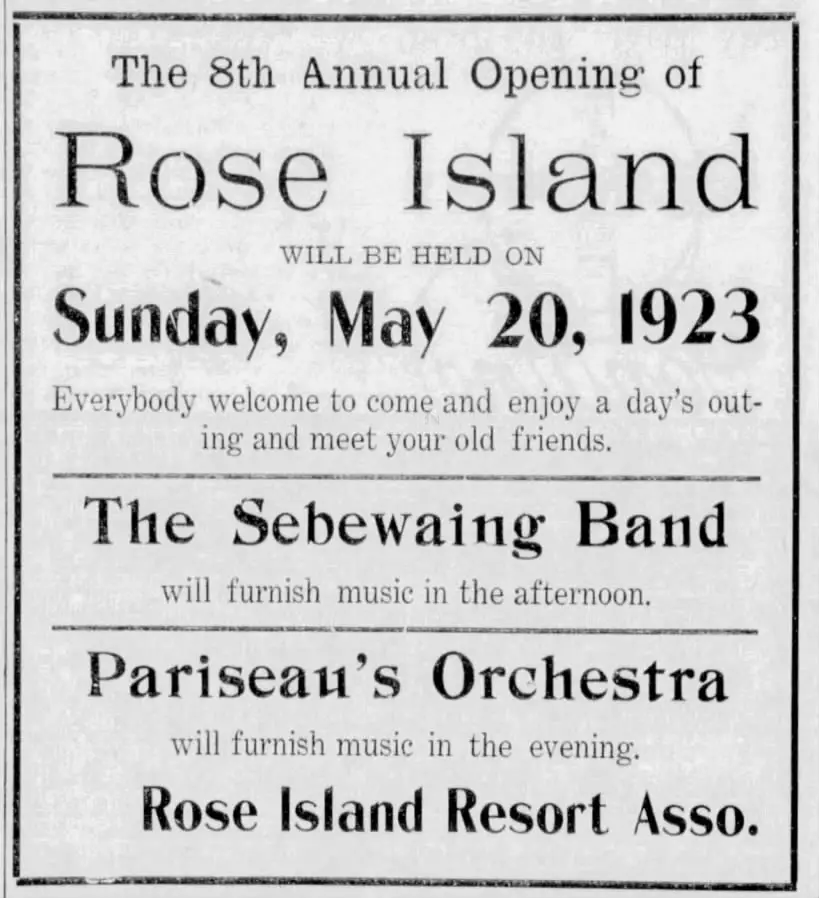
Community groups and bands were a big part of the appeal. The Sebewaing town band frequently performed on Rose Island, and local orchestras played on summer nights. Ads for the resort trumpeted that picnickers and school or church groups were “always welcome,” with plenty of tables and good grounds for basket lunches. Cottages were available to rent by the day or week, offering shaded spots for larger groups. In fact, Rose Island staged annual opening day celebrations each spring: by 1923, newspapers announced it was holding its “8th Annual Opening” on a Sunday in May, with the Sebewaing Band providing music all afternoon. This suggested the Rose Island Resort drew a loyal following – families and former visitors returning each year to kick off the summer season together.
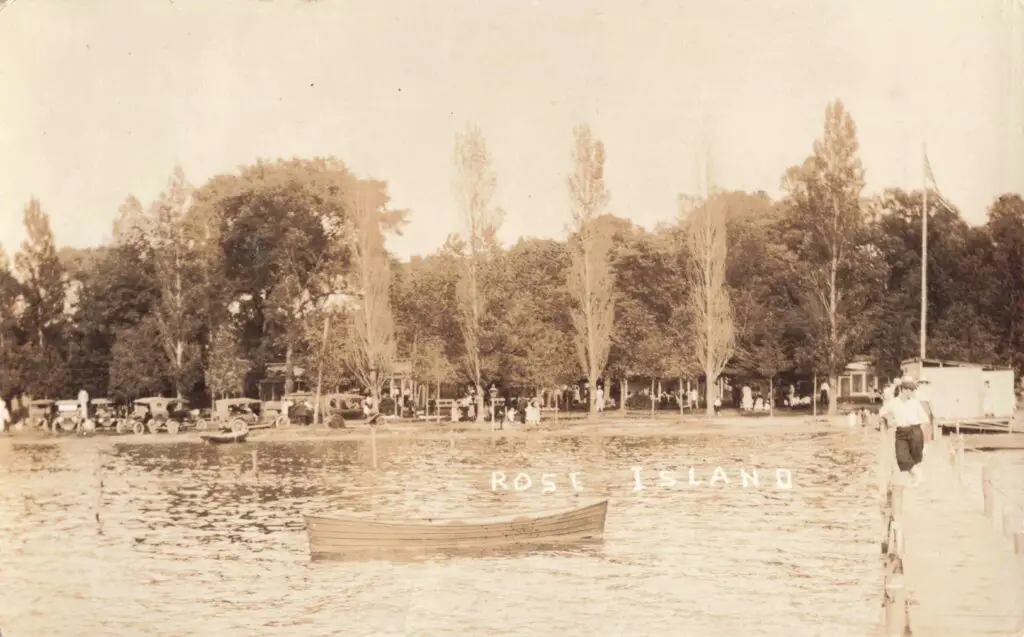
Like many bayfront resorts, Rose Island catered to all ages. Children could play in the sand and swim; teenagers and young adults could race canoes or rowboats. Sports enthusiasts might join a baseball game on the island’s diamond (as local news anticipated in 1916) or watch boat races organized by clubs. In the evenings, the pavilion’s lights and music drew crowds dancing beneath the stars. The on-site hotel served meals throughout the day – by the 1930s it was even known for hearty lake-style dinners featuring chicken, fish and frog legs. In short, Rose Island combined a beach and bathing resort with a campground and picnic park – a full summer playground aimed at Midwestern vacationers seeking cool breezes off Saginaw Bay.
Celebrations and Community Spirit
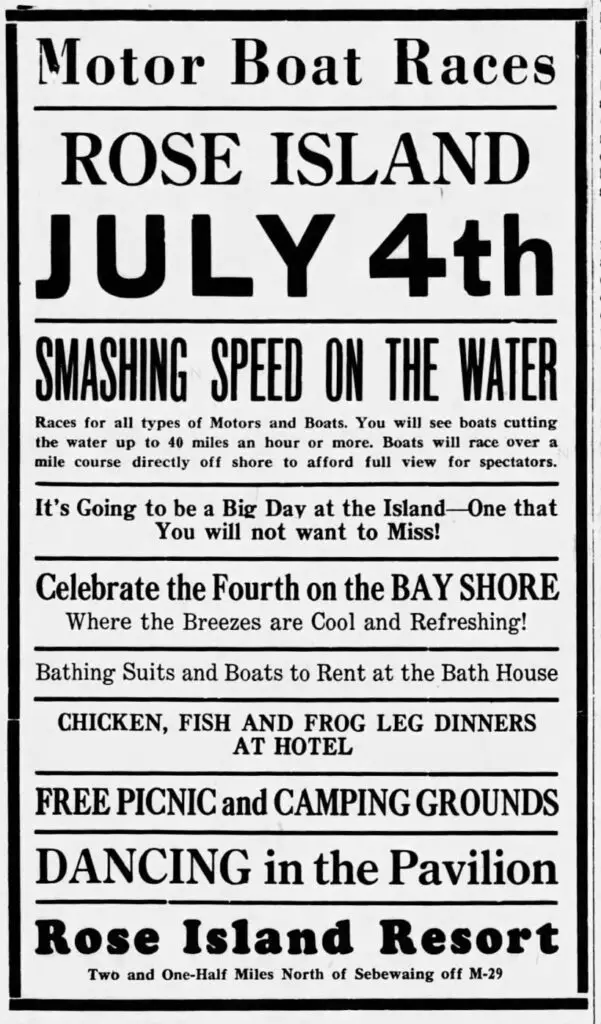
Fourth of July and other holiday gatherings were among Rose Island’s busiest times. Throughout the early decades, each Independence Day was celebrated on the “bay shore,” often with special events. For example, a 1930 resort advertisement promised motorboat races off the island’s beach: “smashing speed on the water” with four contests for fourteen boats, “directly off shore to afford full view for spectators.” The ad urged everyone to make July 4th at Rose Island Resort a day not to be missed, highlighting free picnic and camping grounds and dancing in the pavilion. In practice, these Fourth?of?July programs attracted huge crowds: local papers reported that on July 4, 1930 some 1,500 people – the largest in the resort’s history – turned out to watch the speedboat regatta and enjoy the festive atmosphere.
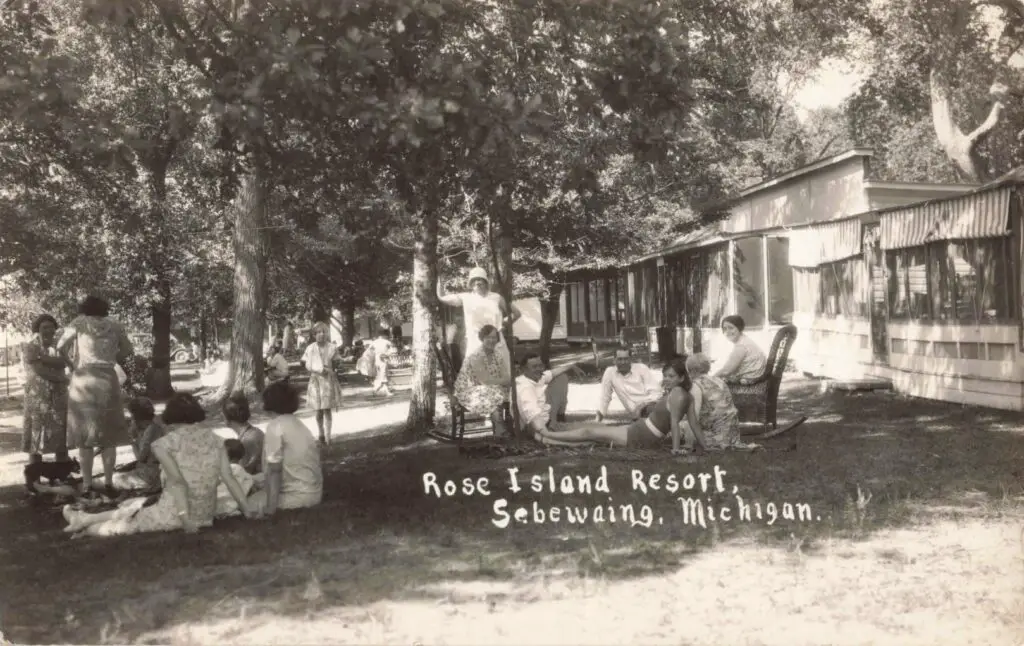
Music and parades were also part of the pageantry. The Sebewaing Band’s annual May concerts were matched by Fourth?of?July bands and even community picnics. These events reinforced Rose Island’s role as a focal point for the small towns along the bay. The 1923 ad, for example, invited “everybody… to come and enjoy a day’s outing and meet your old friends,” noting that both afternoon and evening music would be provided by local orchestras. In the spirit of the era, Rose Island was seen as a community gathering spot – the place where neighboring townsmen could celebrate summer together under the pines and elms by the water.
Storms and Setbacks
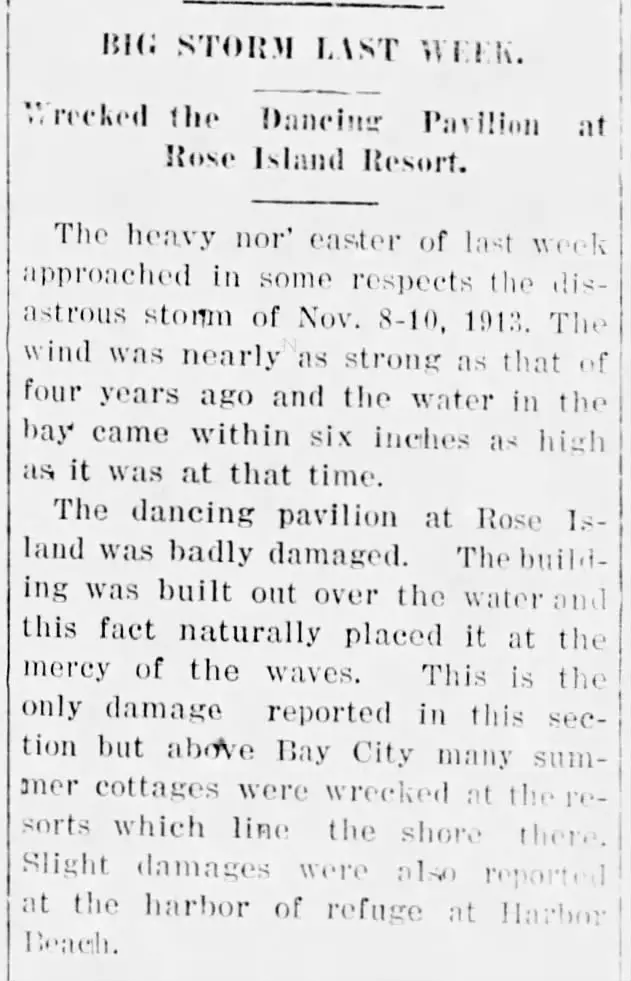
While Rose Island flourished with warm weather festivities, it was not immune to nature’s fury. In November 1917 a powerful nor’easter swept across the bay. According to a contemporary report, the storm “approached in some respects [the force of] the disastrous storm of Nov. 8-10, 1913,” lashing the coast with hurricane winds. The worst damage at Rose Island was to its wooden dance pavilion: a newspaper headline bluntly declared “Big Storm Last Week Wrecked the Dancing Pavilion at Rose Island Resort”. The pavilion – built out over the water on pilings – was swept nearly off its foundations, its boards and supports badly mangled. Amazingly, this was “the only damage reported in this section,” though cottages and bathhouses in neighboring areas also suffered. The 1917 storm served as a reminder that bay resorts had to contend with Lake Huron’s unpredictable weather: high water and wind could erase parts of their handiwork overnight. Yet the community did not abandon the Rose Island Resort; with spring the next year, crews repaired the pavilion and continued with the summer’s planned activities.
The 1920s and 1930s: A Summer Mecca
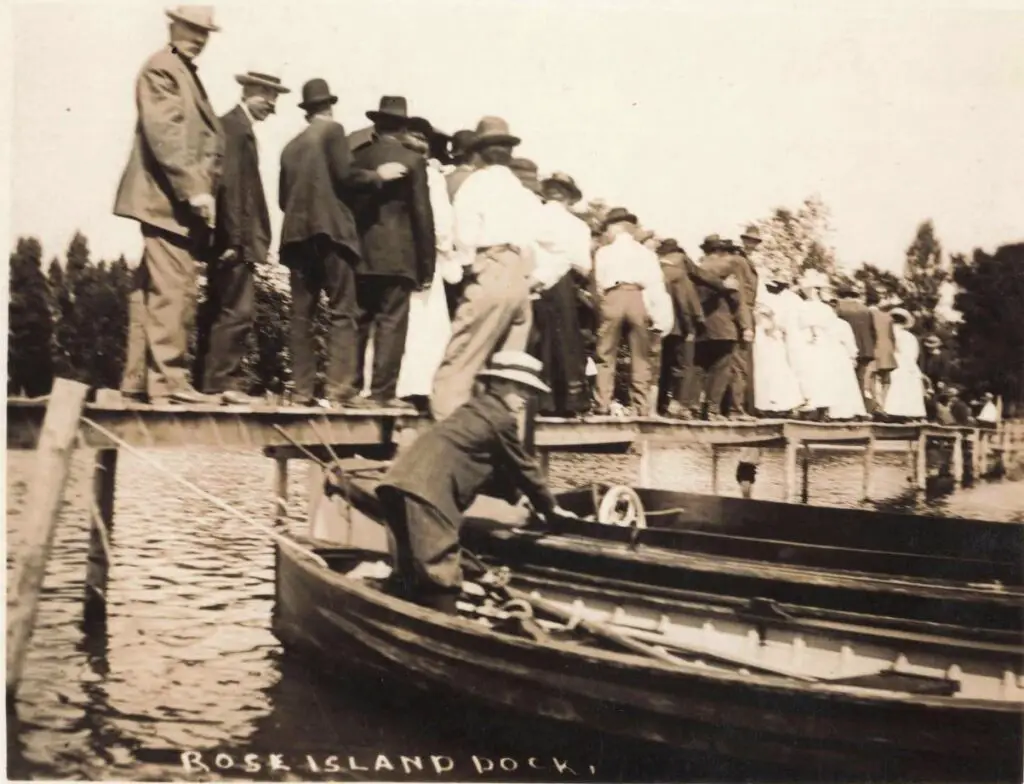
In the postwar decades Rose Island maintained its place as a Thumb-area resort. Ownership eventually passed out of the Durkees’ hands; by 1930 the property was run by the Peters family (often referred to as “Peters Brothers” in the papers). Under the Peters Brothers, Rose Island continued to be “put on the map” as a local getaway. They freshened up the facilities – one report notes that cottages were repainted, a new bathhouse had been built on the shore, and various improvements were added – and they maintained the resort’s traditions of band music, boating and dining.
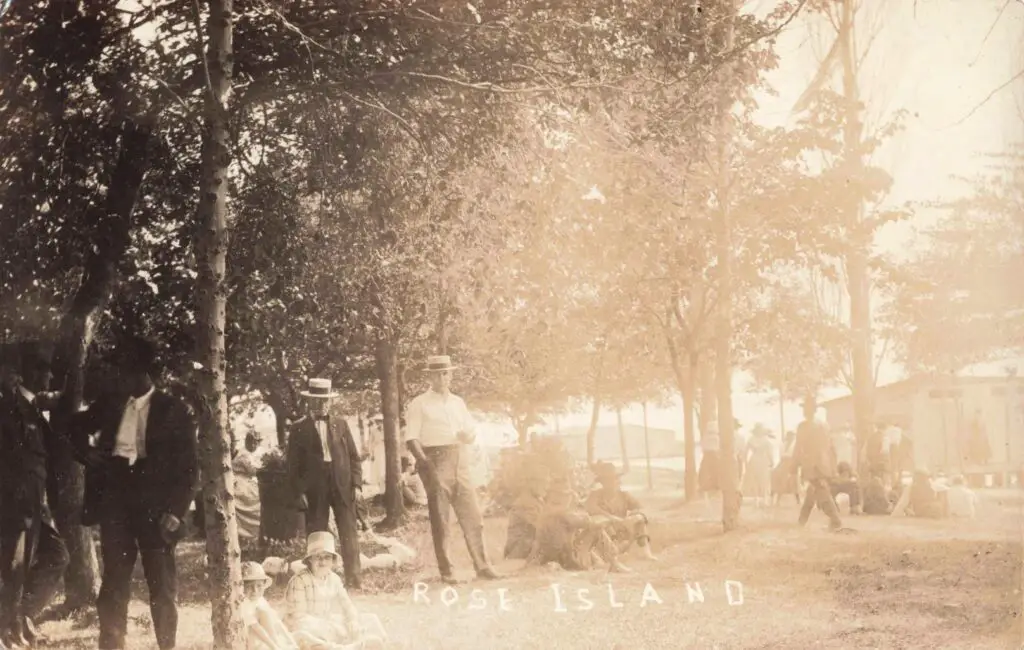
The highlight of summer was still the Independence Day celebration. In 1930, as noted, speed-boat racing was the main attraction, with fourteen local boats competing in four classes of motor size. In what was a point of pride, all the raceboats were owned by area residents. That Fourth brought “the biggest crowd of pleasure seekers in its history” to Rose Island, reports said, as nearly the entire bay community turned out for an idyllic sunny day on the water. The hotel’s kitchen was busy serving meals all day (local newspapers even mentioned “chicken and frog leg dinners” in the hotel), and into the evening Rose Island lived up to its reputation as a lively dance spot. A resort ad from that era proclaimed: “Celebrate the Fourth on the Bay Shore where the breezes are cool and refreshing!” – an inviting promise backed up by the crowds who had come to enjoy the races, picnics, and pavilion dances.
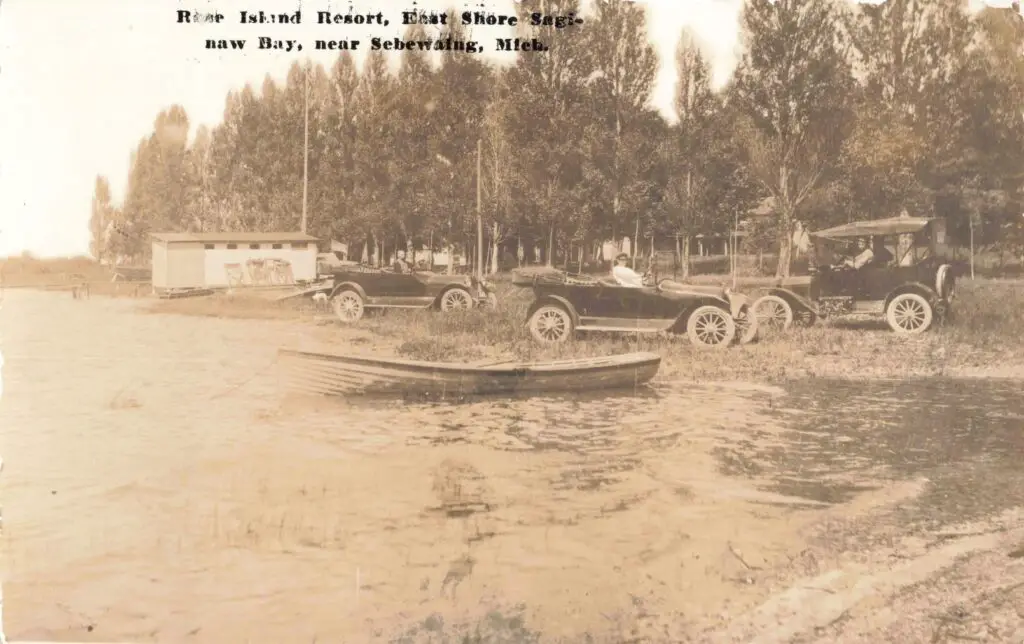
By this time Rose Island’s amenities were well-established: boat rentals from the bathhouse, cottages for week-long stays, the hotel restaurant, picnic groves and the pavilion were all part of the visitor experience. Stories of the day–long open-air dance parties and twilight band concerts suggest that in the 1920s and ’30s the resort was firmly embedded in Thumb summer culture. Although the Great Depression was beginning to bite, locals still remembered Rose Island as the place to spend a holiday or Sunday outing along Saginaw Bay.
Sebewaing and Saginaw Bay – The Bigger Picture
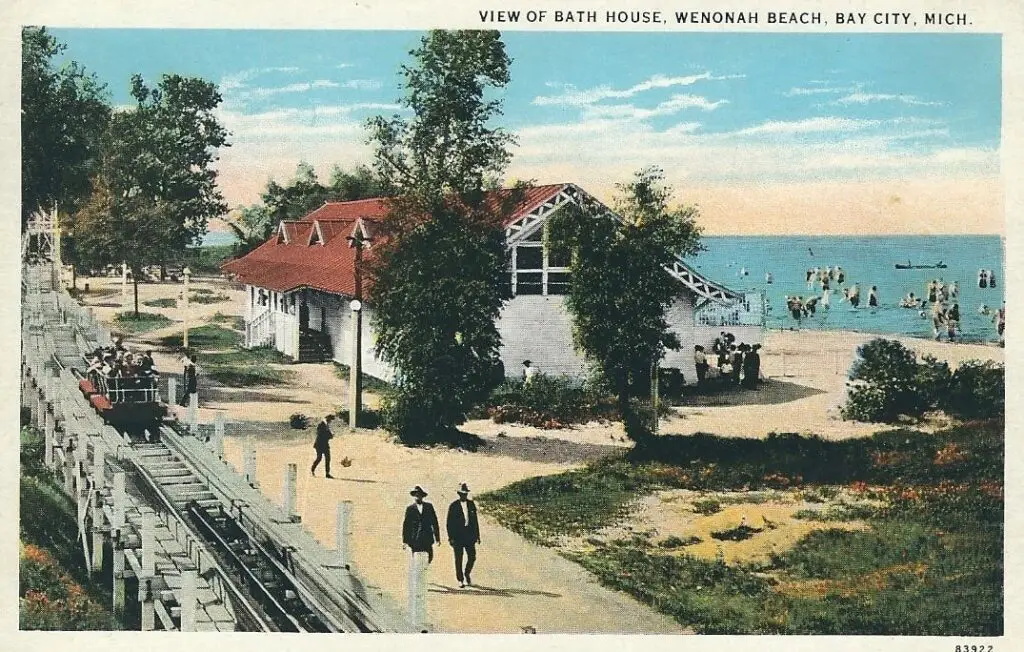
Rose Island Resort was just one piece of the Thumb’s larger lakeside tradition. Throughout the late 19th and early 20th centuries, Saginaw Bay’s warm shores sprouted many vacation spots. One famous example was Wenona Beach in Bay City – an amusement park founded in 1890 by lumber barons. It was called the “Coney Island of the Lakes,” featuring a huge pavilion, a boardwalk, boating, bathhouses, and even a dance ballroom for summer tourists. By the 1910s that park and others offered entertainment very much like Rose Island’s – swimming, carnival games, vaudeville shows and, of course, dancing. In that context, Rose Island’s promotion of swimming, fishing, boat races and a pavilion dance floor was in line with popular regional attractions.
Sebewaing today still capitalizes on its bayfront setting. The village maintains a marina, a county campground and waterfront parks, and hosts festivals in the summer. While Rose Island itself no longer operates as a resort, its history is a window into the era when families sought out fresh breezes on Lake Huron and small communities grew around these seasonal pleasures. Over a quarter-century, Rose Island served thousands of visitors, from picnicers and fishermen to dancers and sunbathers, playing a memorable role in the leisure life of the bay shore.
Sources: Contemporary newspaper accounts (1916–1930) of Rose Island Resort, including sale and opening announcements, advertisements for July 4th events, and reports of storm damage. Travel and history sources on Sebewaing and Saginaw Bay (Michigan travel site and Wenona Beach history) provide context.



